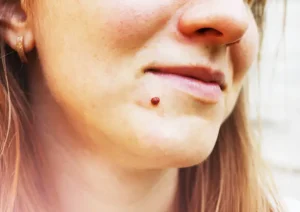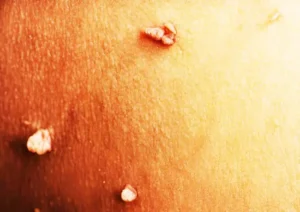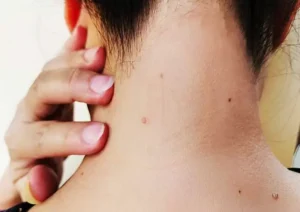What Causes Warts and Moles on the Body
Warts and moles often appear unexpectedly on the skin, causing many to wonder about their origins.
These common skin spots have different causes and play unique roles in skin health.
Understanding what triggers warts and moles not only helps you care for your skin better
but also raises awareness about when to seek medical attention.
Causes and Mechanism of Warts Formation
Warts are small, rough skin growths caused by an infection with the human papillomavirus (HPV).
This virus invades the skin through tiny cuts or abrasions, setting off a chain reaction that leads to rapid skin cell growth
and the characteristic bump we call a wart.
Human Papillomavirus (HPV) Infection
HPV isn’t just one virus but a group of related viruses that infect skin cells.
When HPV finds its way into the skin, usually through a scratch or break, it hijacks the normal skin cell cycle.
he virus forces the infected skin cells to multiply quickly, resulting in the raised, often rough surface of a wart.
These infections are highly contagious and can spread through direct skin contact or by touching surfaces that harbor the virus.
Types of Warts and Associated HPV Strains
Warts vary in appearance and location, often linked to different HPV strains:
- Common Warts: Usually found on fingers and hands, caused by HPV types 2 and 4.
- Plantar Warts: Found on the soles of feet, can cause discomfort when walking; linked to HPV type 1.
- Flat Warts: Smooth, smaller warts commonly appearing on the face, back of hands, or legs; related to HPV types 3 and 10.
- Genital Warts: Occur in the genital areas and are linked to HPV types 6 and 11.
You can find detailed descriptions of these variations in medical sources like the Cleveland Clinic’s overview on warts.
Risk Factors and Transmission
Certain factors make people more prone to warts:
- Age: Children and young adults get warts more often.
- Immune System: A weakened immune system struggles to fight off HPV.
- Skin Exposure: Frequent skin contact or minor injuries provide entry points for the virus.
Warts spread through direct contact with an infected person or by touching contaminated surfaces like floors in communal showers or
swimming pools. Sharing personal items like towels can also aid transmission.
Body’s Immune Response and Wart Resolution
Fortunately, the immune system can often recognize and clear HPV infection over time.
This is why many warts disappear without treatment, sometimes taking months or even years.
Some people’s immune responses are stronger or quicker, which affects how long warts last.

Causes and Influences on Mole Development
Unlike warts, moles aren’t infectious. They form from clusters of pigment-producing cells called melanocytes.
The development and appearance of moles depend on genetics, lifestyle factors, and hormones.
Melanocyte Clusters and Genetic Factors
Moles are created when melanocytes group together instead of spreading evenly across the skin.
This cluster forms a visible spot that can be flat or raised. Your genes largely determine the number, size, and color of your moles.
Some families naturally have more moles than others.
Role of Sun Exposure and UV Radiation
Sunlight, particularly ultraviolet (UV) rays, stimulates melanocytes to produce melanin, the pigment that colors your skin.
Overexposure to UV rays may lead to more moles. Continuous sun exposure can also cause existing moles to darken.
This effect underscores the importance of sun protection to lower risks of skin changes that might turn dangerous.
Hormonal Influences on Moles
Hormonal shifts during adolescence, pregnancy, or aging can cause moles to change in size, shape, or color.
This is why moles sometimes appear or change during these phases.
Hormones influence melanocyte activity, making the skin more reactive.
Types of Moles and Their Malignant Potential
Moles come in a few categories with different health risks:
- Common Moles: Small, uniform in color and shape, usually harmless.
- Atypical (Dysplastic) Moles: Larger, irregular edges or color variations, which increase melanoma risk.
- Congenital Moles: Present from birth, some larger types have elevated risks for skin cancer.
It’s useful to check moles regularly to keep an eye on any changes. Trusted sources like Dermatology
Seattle provide good insight into differentiating moles and warts.
Prevention, Monitoring, and When to Seek Medical Advice
Knowing how to avoid warts and monitor moles helps keep your skin healthy and potentially catches problems early.
Preventive Measures for Warts and Moles
- Maintain good hygiene and keep skin clean and dry to reduce HPV infection chances.
- Avoid picking at warts and keep minor cuts covered.
- Use sunscreen with broad-spectrum protection to shield your skin from harmful UV rays and prevent new or changing moles.
- Consider HPV vaccination, which can prevent many strains of the virus responsible for warts.
Self-Monitoring Techniques for Skin Changes
The ABCDE method helps track mole changes that might signal trouble:
- Asymmetry: One half doesn’t match the other.
- Border: Edges are irregular or blurred.
- Color: Multiple colors or uneven color.
- Diameter: Larger than 6mm (about the size of a pencil eraser).
- Evolving: Any change in size, shape, color, or symptoms.
Keep an eye on warts too—if they suddenly grow larger, change color, become painful, or bleed, these are signs to consult a professional.

When to Consult a Dermatologist
Seek medical advice if you notice:
- Rapid growth or changes in a mole or wart.
- New bleeding, itching, or pain.
- Moles that look different from others (the “ugly duckling” sign).
- Warts that persist despite treatment or spread quickly.
Early diagnosis can lead to better outcomes, especially if skin cancer is a concern.
Conclusion
Warts and moles may seem similar at a glance, but their causes and risks are very different.
Warts come from a viral infection (HPV), and their spread can be managed with good hygiene and care.
Moles arise from pigment cell clusters, influenced by genetics, sun exposure, and hormones.
Watching your skin for changes, protecting it from damage,
and knowing when to seek expert help are the best ways to keep your skin safe and healthy.
Taking care of your skin means not only treating these spots but understanding what causes them in the first place.
This knowledge empowers you to spot issues early and maintain clear, healthy skin throughout your life.
HOSTINGER HOST PLAN DISCOUNT CODE
